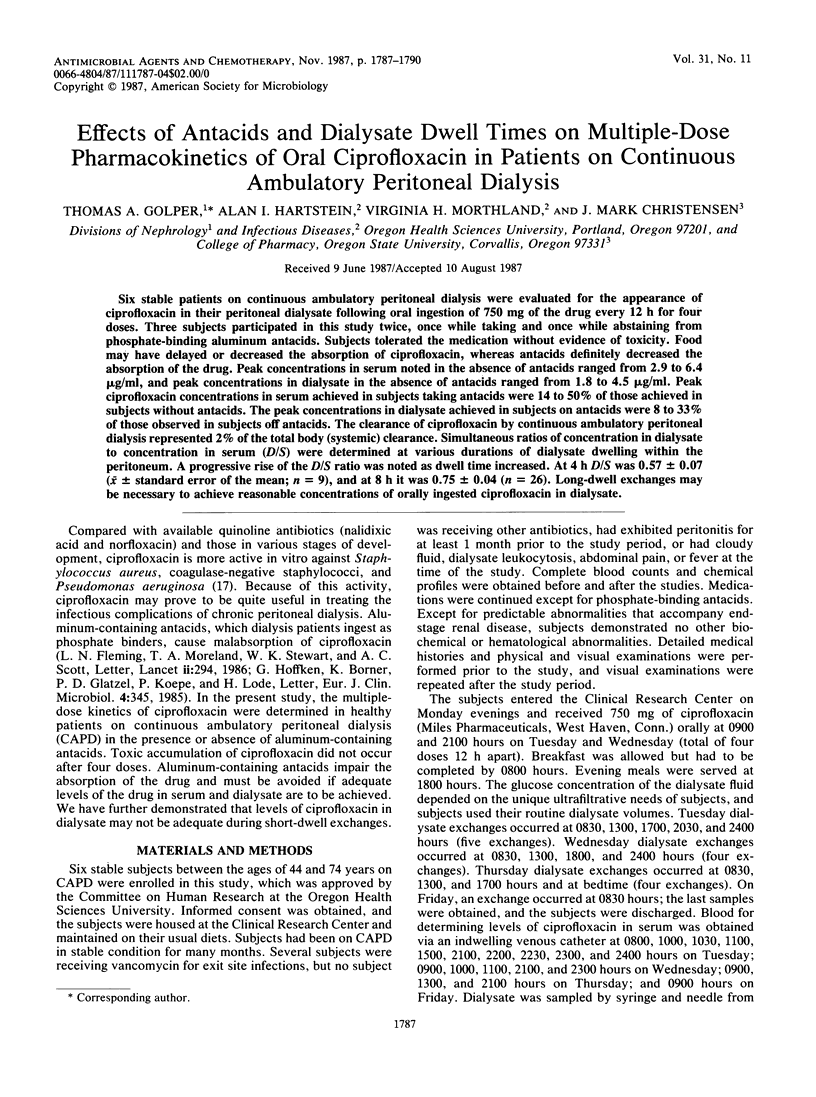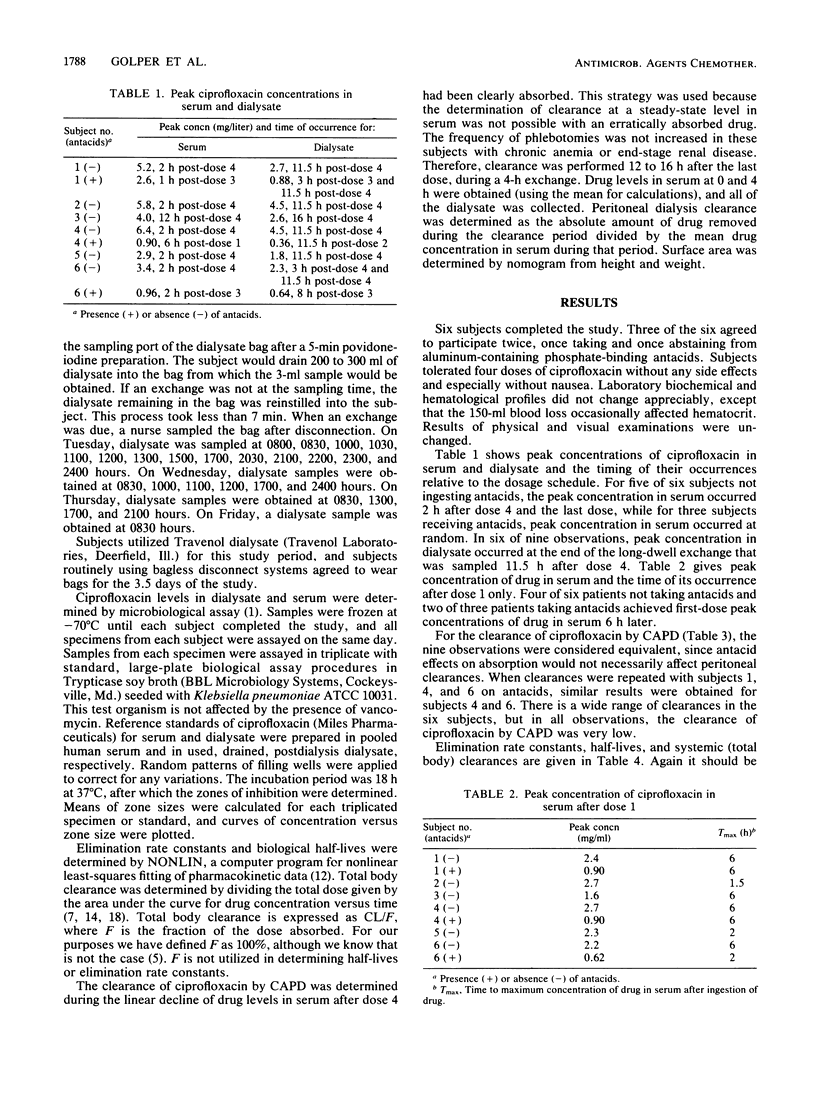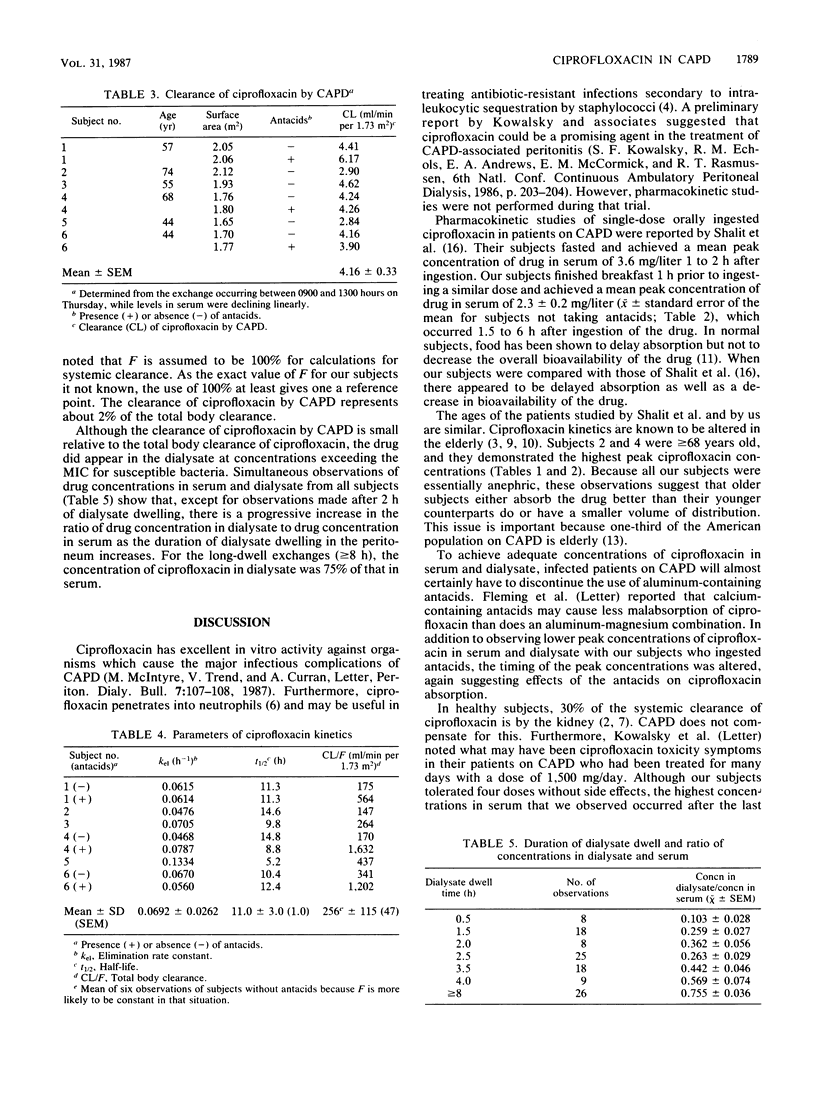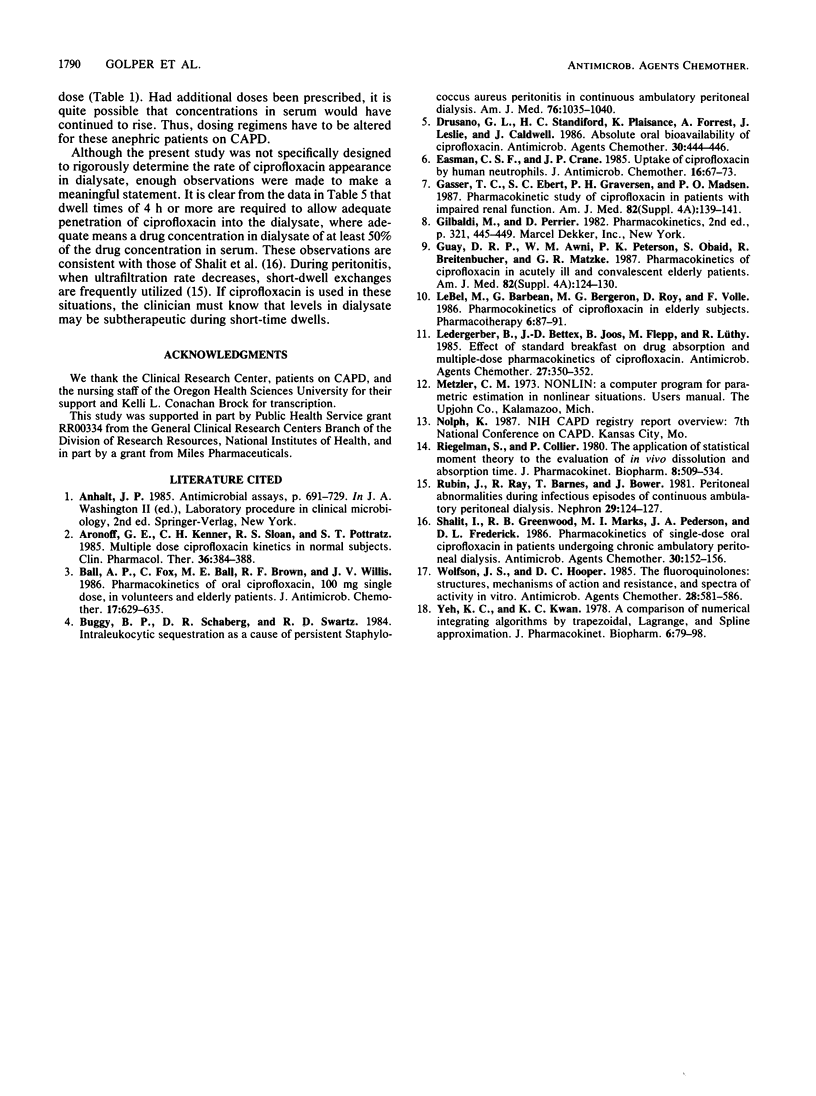Abstract
Six stable patients on continuous ambulatory peritoneal dialysis were evaluated for the appearance of ciprofloxacin in their peritoneal dialysate following oral ingestion of 750 mg of the drug every 12 h for four doses. Three subjects participated in this study twice, once while taking and once while abstaining from phosphate-binding aluminum antacids. Subjects tolerated the medication without evidence of toxicity. Food may have delayed or decreased the absorption of ciprofloxacin, whereas antacids definitely decreased the absorption of the drug. Peak concentrations in serum noted in the absence of antacids ranged from 2.9 to 6.4 micrograms/ml, and peak concentrations in dialysate in the absence of antacids ranged from 1.8 to 4.5 micrograms/ml. Peak ciprofloxacin concentrations in serum achieved in subjects taking antacids were 14 to 50% of those achieved in subjects without antacids. The peak concentrations in dialysate achieved in subjects on antacids were 8 to 33% of those observed in subjects off antacids. The clearance of ciprofloxacin by continuous ambulatory peritoneal dialysis represented 2% of the total body (systemic) clearance. Simultaneous ratios of concentration in dialysate to concentration in serum (D/S) were determined at various durations of dialysate dwelling within the peritoneum. A progressive rise of the D/S ratio was noted as dwell time increased. At 4 h D/S was 0.57 +/- 0.07 (mean +/- standard error of the mean; n = 9), and at 8 h it was 0.75 +/- 0.04 (n = 26). Long-dwell exchanges may be necessary to achieve reasonable concentrations of orally ingested ciprofloxacin in dialysate.
Full text
PDF



Selected References
These references are in PubMed. This may not be the complete list of references from this article.
- Aronoff G. E., Kenner C. H., Sloan R. S., Pottratz S. T. Multiple-dose ciprofloxacin kinetics in normal subjects. Clin Pharmacol Ther. 1984 Sep;36(3):384–388. doi: 10.1038/clpt.1984.192. [DOI] [PubMed] [Google Scholar]
- Ball A. P., Fox C., Ball M. E., Brown I. R., Willis J. V. Pharmacokinetics of oral ciprofloxacin, 100 mg single dose, in volunteers and elderly patients. J Antimicrob Chemother. 1986 May;17(5):629–635. doi: 10.1093/jac/17.5.629. [DOI] [PubMed] [Google Scholar]
- Buggy B. P., Schaberg D. R., Swartz R. D. Intraleukocytic sequestration as a cause of persistent Staphylococcus aureus peritonitis in continuous ambulatory peritoneal dialysis. Am J Med. 1984 Jun;76(6):1035–1040. doi: 10.1016/0002-9343(84)90854-4. [DOI] [PubMed] [Google Scholar]
- Drusano G. L., Standiford H. C., Plaisance K., Forrest A., Leslie J., Caldwell J. Absolute oral bioavailability of ciprofloxacin. Antimicrob Agents Chemother. 1986 Sep;30(3):444–446. doi: 10.1128/aac.30.3.444. [DOI] [PMC free article] [PubMed] [Google Scholar]
- Easmon C. S., Crane J. P. Uptake of ciprofloxacin by human neutrophils. J Antimicrob Chemother. 1985 Jul;16(1):67–73. doi: 10.1093/jac/16.1.67. [DOI] [PubMed] [Google Scholar]
- Guay D. R., Awni W. M., Peterson P. K., Obaid S., Breitenbucher R., Matzke G. R. Pharmacokinetics of ciprofloxacin in acutely ill and convalescent elderly patients. Am J Med. 1987 Apr 27;82(4A):124–129. [PubMed] [Google Scholar]
- LeBel M., Barbeau G., Bergeron M. G., Roy D., Vallée F. Pharmacokinetics of ciprofloxacin in elderly subjects. Pharmacotherapy. 1986 Mar-Apr;6(2):87–91. doi: 10.1002/j.1875-9114.1986.tb03458.x. [DOI] [PubMed] [Google Scholar]
- Ledergerber B., Bettex J. D., Joos B., Flepp M., Lüthy R. Effect of standard breakfast on drug absorption and multiple-dose pharmacokinetics of ciprofloxacin. Antimicrob Agents Chemother. 1985 Mar;27(3):350–352. doi: 10.1128/aac.27.3.350. [DOI] [PMC free article] [PubMed] [Google Scholar]
- Riegelman S., Collier P. The application of statistical moment theory to the evaluation of in vivo dissolution time and absorption time. J Pharmacokinet Biopharm. 1980 Oct;8(5):509–534. doi: 10.1007/BF01059549. [DOI] [PubMed] [Google Scholar]
- Rubin J., Ray R., Barnes T., Bower J. Peritoneal abnormalities during infectious episodes of continuous ambulatory peritoneal dialysis. Nephron. 1981;29(3-4):124–127. doi: 10.1159/000182328. [DOI] [PubMed] [Google Scholar]
- Shalit I., Greenwood R. B., Marks M. I., Pederson J. A., Frederick D. L. Pharmacokinetics of single-dose oral ciprofloxacin in patients undergoing chronic ambulatory peritoneal dialysis. Antimicrob Agents Chemother. 1986 Jul;30(1):152–156. doi: 10.1128/aac.30.1.152. [DOI] [PMC free article] [PubMed] [Google Scholar]
- Wolfson J. S., Hooper D. C. The fluoroquinolones: structures, mechanisms of action and resistance, and spectra of activity in vitro. Antimicrob Agents Chemother. 1985 Oct;28(4):581–586. doi: 10.1128/aac.28.4.581. [DOI] [PMC free article] [PubMed] [Google Scholar]
- Yeh K. C., Kwan K. C. A comparison of numerical integrating algorithms by trapezoidal, Lagrange, and spline approximation. J Pharmacokinet Biopharm. 1978 Feb;6(1):79–98. doi: 10.1007/BF01066064. [DOI] [PubMed] [Google Scholar]


